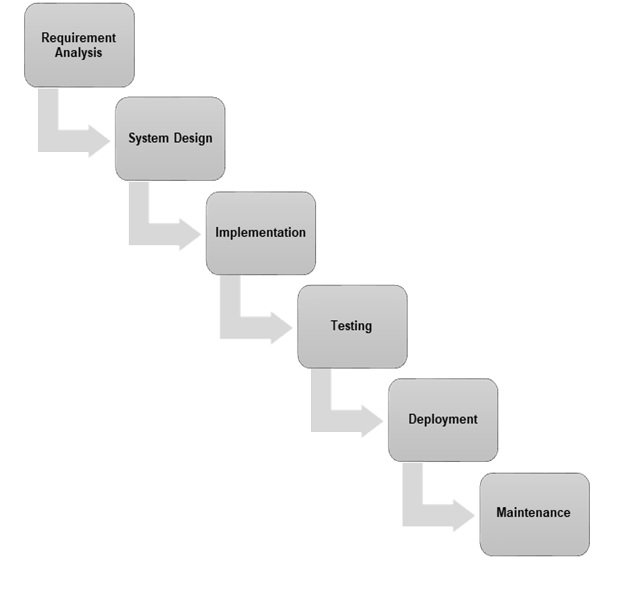Types Of SDLC¶
Software projects follow a methodology of clearly defined processes or software development life cycle (SDLC) to ensure that the end product is of high quality. An SDLC identifies stages and the structured flow from one stage to another stage. Typically, there are six to seven stages in its various types that are as follows:
Waterfall Methodology¶
Waterfall Methodology is also known as Linear Sequential Life Cycle Model. That means that any stage in the development process begins only if the previous stage is complete. In this waterfall model, the stages do not overlap. Waterfall has no scope of changing the requirements once the project development starts.

Waterfall Methodology
There are following six stages in Waterfall Methodology:
| S.no | Stage | Activities Involved | People Involved | Deliverables |
|---|---|---|---|---|
| 1. | Requirement Analysis | 1. Gather the list of feature requirements. 2. Understand the technology requirement. 3. Calculate the number of people required for a project. 4. Understand customer requirements properly. | Project Manager, Consultant, Architect, Business Analyst | Requirement Understanding Document |
| 2. | System Design | 1.Create the design as mentioned in the requirement document. 2. Understand why, how of the features to implement. 3. Check if any change in design such as UI, image, etc is needed. 4. Document the design requirement. | Solution Architect, Tech Manager | Design Document |
| 3. | Implementation | 1. Develop the program or code as per the design document. 2. Run the unit test cases for codes. | Tech lead, Developers | Codes, Unit test cases and Results |
| 4. | Testing | 1. Test the feature work or not. 2. Test new features with old ones. 3. Report bugs if any. 4. Track the progress of testing. 5. Report testing activities. | Quality Assurance Manager, Tech Manager | Test cases, Test reports |
| 5. | Deployment | 1. Make sure product is ready for release in respective environment. 2. Fix number of features and issues for a release. 3. Final check to fix a product release. | Business Manager, Tech Lead Developers | User Manual |
| 6. | Maintenance | 1. Confirm customers use the product. 2. Incase customer encounters the bug, note the issue and fix it. 3. The application is enhanced to incorporate new features, and update it. | Support Team, Developers | User Manual, Support Contact Details |
Advantages of Waterfall Methodology¶
-
Each stage has specific deliverables and a review process and is thus one of the easiest methodologies to manage.
-
Best suited for smaller size projects.
-
Project delivery is faster as each stage is rigid and well-defined.
-
Documentation of stages and processes is easy.
-
Perfect when you know exactly what it takes to get what you want.
-
The environment is stable.
Limitations of Waterfall Methodology¶
- Less effective method if the requirements are not clear at the beginning.
- It is not an ideal model for a large size project.
- Difficult as well as costly affair to move back to the previous stage to make changes as deliverables are fixed.
- Each phase is owned by a different team. There is little collaboration between teams.
- The tools and techniques used are stable and are not dynamic.